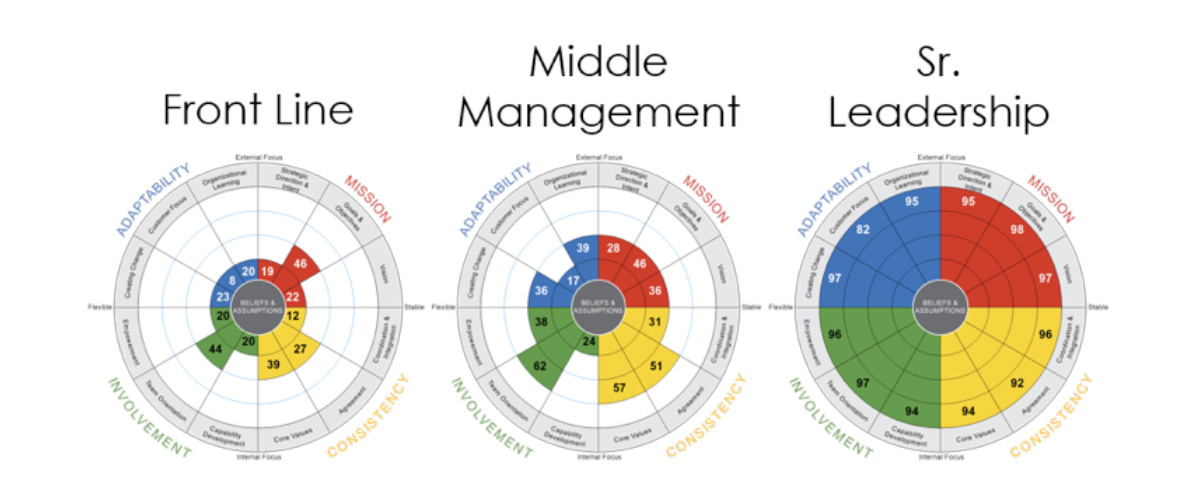In a recent LinkedIn post, I asked people to think beyond leadership development and to think about leadership alignment. This is something that our work in the culture and leadership arena has highlighted as a critical issue facing many organizations across the globe. The message seemed to resonate, resulting in one of our highest rated posts to date. To illustrate the need, I shared the image below that shows the culture perspectives of THREE levels of leaders in ONE organization. Clear, colorful and aligned if you sit at the top. More ambiguous and fractured as you get closer to where the work happens.
Why did this message attract so much attention? We get to see, in living color, the disconnects across levels in hundreds of organizations every year. Clearly, others not only see it – they feel it every day in their organizations. The gap rears its ugly head in many ways. The lack of clarity regarding strategies and goals results in missed targets, ambiguous priorities, conflicting activities and unmet expectations. Middle managers get squeezed. Senior leaders ask, “Why don’t others get it?” The front lines focus on what they need to do day-to-day while asking themselves, “Why do we do it this way?”
Consider what the culture profiles above tell us. If our excursion into this company starts at the top, we see a Senior team that believes their organization is crystal clear on the Vision, Strategy and Goals. They are certain they have the skills in the organization to execute against those strategies and goals, and that various departments and locations are effectively coordinating in service of those strategies and goals. The Senior leaders see a change-ready, customer-focused enterprise.
As our excursion takes us into the middle management levels, that clarity begins to blur. The vision and strategy are vague. Goals, though a bit stronger, are anything but crystal clear. There is little confidence that the organization has the skills needed to execute, and the perceived lack of coordination is a clear indication that silo behavior is prevalent. Middle managers struggle with implementing change and fail to see how the organization is meeting customer expectations.
We end our excursion in this organization with a tour of the front line. The emphasis on goals and the absence of a clear vision and strategy result in a focus on the day-to-day. Those closest to the work believe their work is reactive and fail to understand how their activities contribute to a strategy or sense of purpose. Customer awareness is nonexistent. The lack of investment in their skills indicates they are dispensable. They live within the silos that have been created and have little hope that things will change anytime soon.
Unfortunately, many of the habits and routines we employ in organizations reinforce the lack of alignment. We create separate programs for leadership development that are based on level. The front-line supervisors have their meetings, middle managers theirs, and executives have theirs as well. Performance reviews focus on different leadership expectations, again by level. Assumptions are made that communication channels facilitate the free and clear flow of information throughout the organization.
The data that Denison Consulting generates for clients offers insights into many aspects of the culture that impact the performance of their organization, including lack of alignment among various levels of leadership. The ability to quickly identify the areas of misalignment, and to determine the scale and scope of those gaps, is among the most profound insights the culture data provides. Awareness creates opportunity—the opportunity to rethink the communication practices and range of organizational habits and routines that hinder alignment. And, in fact, intervening to achieve leadership alignment may be the most important step in leadership development and increased performance of the organization.
To learn more, demo our Leadership 360 Survey.






